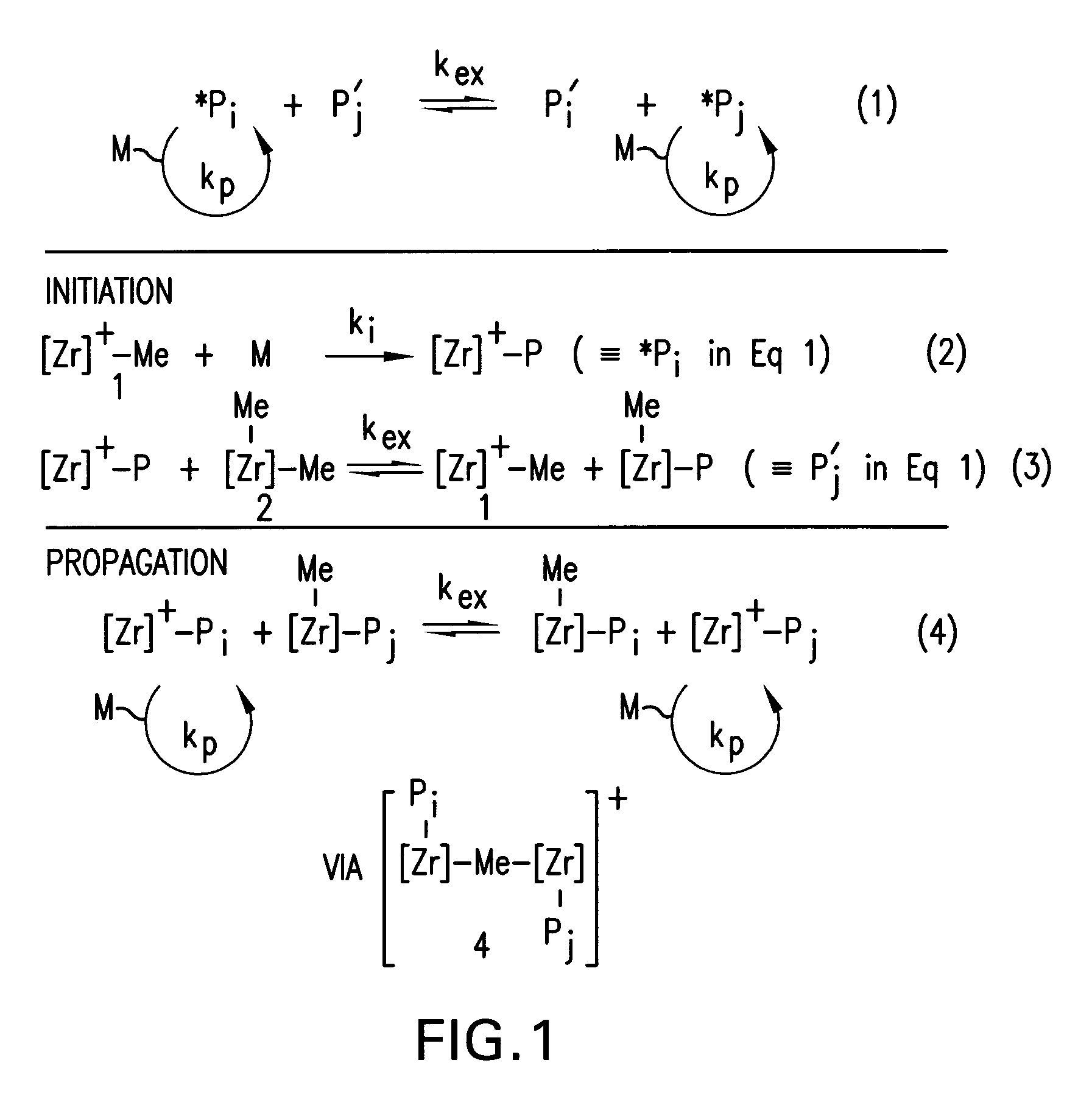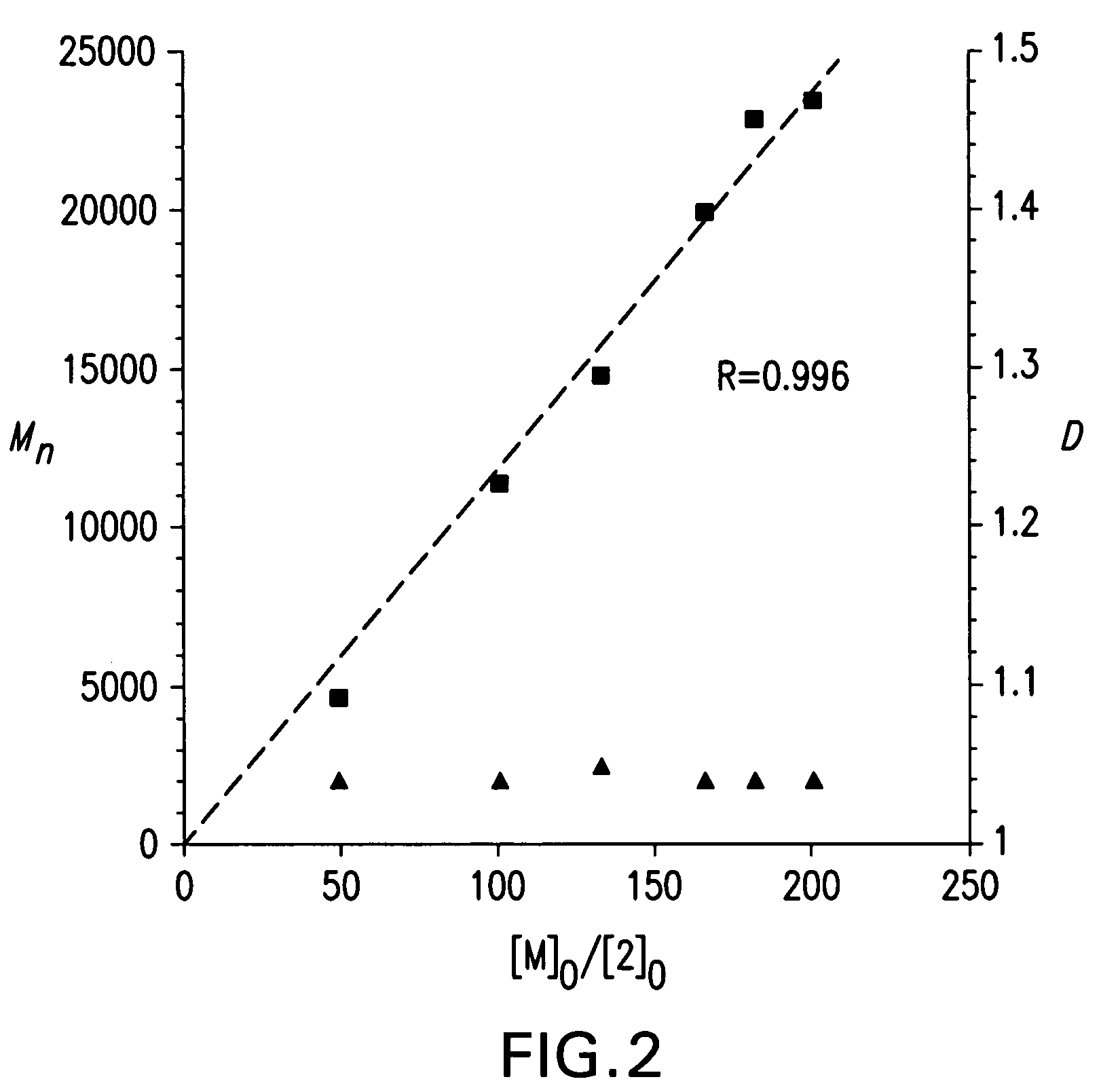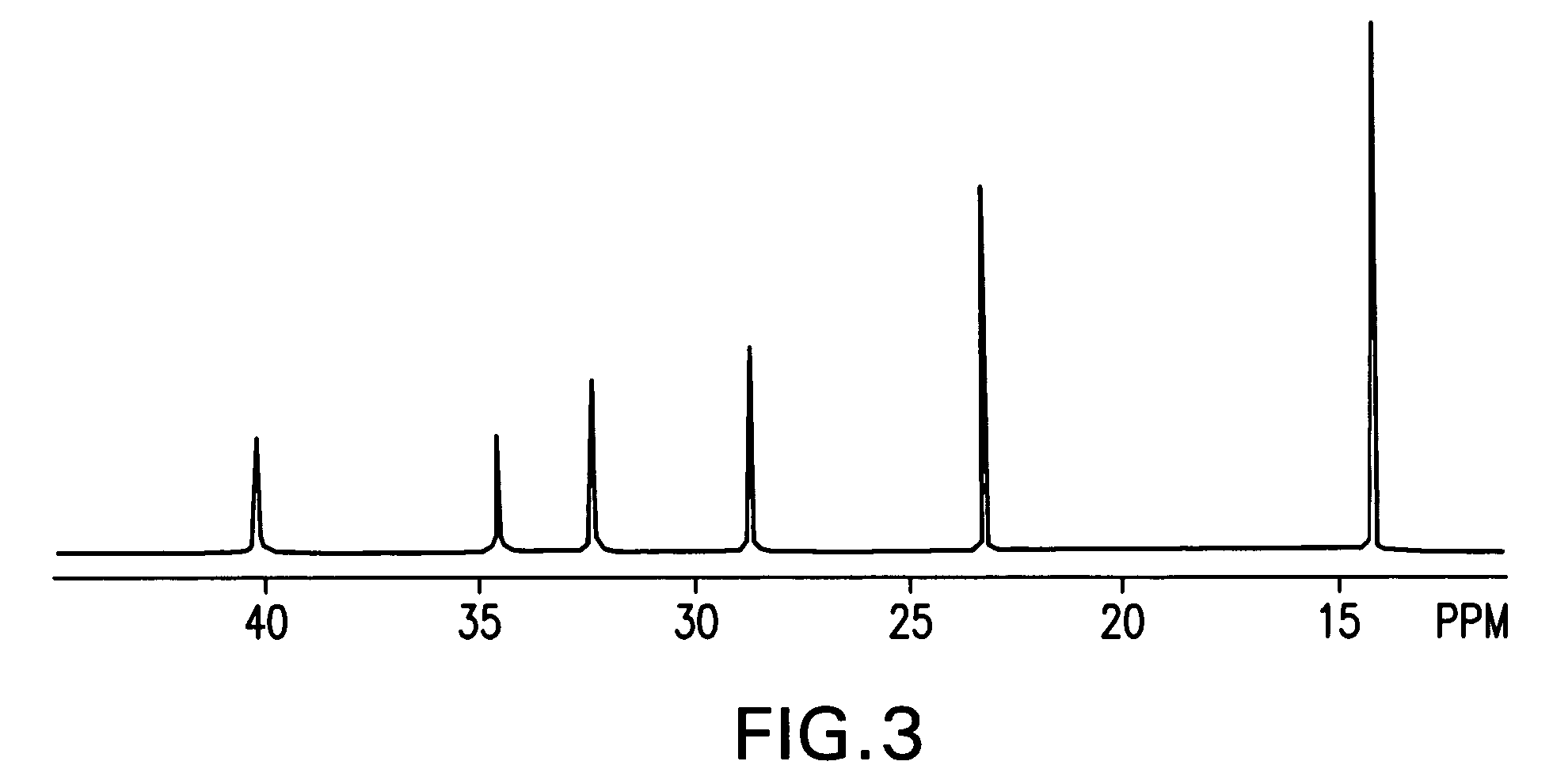Process for preparation of polyolefins via degenerative transfer polymerization
a technology of degenerative transfer and polymerization, which is applied in the field of new olefin polymerization, can solve the problems of reversible deactivation during propagation and its potential consequences, and have not been documented
- Summary
- Abstract
- Description
- Claims
- Application Information
AI Technical Summary
Benefits of technology
Problems solved by technology
Method used
Image
Examples
example 1
[0073]Preparation of Cp*ZrCl(i-Bu)[N(t-Bu)C(Me)N(Et)] (7): To a solution of 2.62 g (6.0 mmol) of 6 in 200 ml of Et2O at −78° C. was added 2.8 ml (6.1 mmol) of a 2.21 M solution of i-BuMgCl in Et2O. After slowly warming to room temperature, the reaction mixture was stirred for an additional hour before quenching with excess chlorotrimethylsilane, after which time, the volatiles were removed in vacuo. The crude product was extracted with toluene and the extracts filtered through a pad of Celite to provide a clear yellow solution, which upon concentration and cooling −35° C., afforded yellow crystals of 7 (2.55 g, 93% yield).
[0074]1H NMR: (400 MHz, benzene-d6, 25° C.), δ 2.81 (dq, 2J=14.3 Hz, 3J=7.2 Hz, 1H), 2.67 (dq, 2J=14.3 Hz, 3J=7.2 Hz, 1H), 2.20 (nonet, 3J=6.4 Hz, 1H), 2.00 (s, 15H), 1.71 (s, 3H), 1.33 (s, 9H), 1.32 (d, 3J=6.4 Hz, 3H), 1.15 (d., 3J=6.4 Hz, 3H), 0.83 (t, 3J=7.2 Hz, 3H), 0.73 (dd, 2J=13.5 Hz, 3J=6.4 Hz, 1H), 0.01 (dd, 2J=13.5 Hz, 3J=6.4 Hz, 1H).
[0075]13C {1H} NMR: δ...
example 2
[0077]Preparation of Cp*ZrMe(i-Bu)[N(t-Bu)C(Me)N(Et)] (5): To a solution of 0.55 g (1.2 mmol) of 7 in 40 ml of Et2O at −78° C. was added 0.9 ml (1.2 mmol) of 1.38 M MeLi in Et2O. After slowly warming to room temperature, the reaction mixture was stirred for an additional hour before quenching with excess chlorotrimethylsilane, after which time the volatiles were removed in vacuo. The crude product was extracted with pentane and the extracts filtered through a thin pad of Celite to provide a clear yellow solution, which upon concentration and cooling to −35° C., afforded yellow crystals of 5 (0.37 g, 71% yield).
[0078]1H NMR: (400 MHz, benzene-d6, 25° C., δ 2.97 (dq, 2J=14.3 Hz, 3J=7.2 Hz, 1H), 2.75 (dq, 2J=14.3 Hz, 3J=7.2 Hz, 1H), 2.20 (m, 1H), 1.98 (s, 15H), 1.80 (s, 3H), 1.27 (d, 3J=6.4 Hz, 3H), 1.20 (d 3J=6.4 Hz, 3H), 1.19 (s, 9H), 0.88 (t, 3J=7.2 Hz, 3H), 0.41 (dd, 2J=13.1 Hz, 3J=6.4 Hz, 1H), 0.23 (s, 3H), −0.25 (dd, 2J=13.1 Hz, 3J=6.4 Hz, 1H).
[0079]Anal. Calcd. for C23H44N2Zr: %...
example 3
[0080]Preparation of [Cp*Zr(i-Bu){N(t-Bu)C(Me)N(Et)}][B(C6F5)4] (8): To 31 mg (3.9 μmol) of 3 was added, at −10° C., a precooled solution of 17 mg (3.7 μmol) of 5 in 0.9 ml of C6D5Cl to provide a yellow solution.
[0081]1H NMR: (500 MHz, −10° C.) δ 3.05 (dq, 2J=13.2 Hz, 3J=6.8 Hz, 1H), 3.04 (dq, 2J=13.2 Hz, 3J=6.8 Hz, 1H), 1.99 (s, 3H), 1.87 (s, 15H), 1.61 (dd, 2J=12.2 Hz, 3J=3.7 Hz, 1H), 1.16 (d, 3J=5.5, 3H), 1.02 (s, 9H), 0.98 (d, 3J=5.5 Hz, 3H), 0.91 (t, 3J=6.8 Hz, 3H), 0.77 (dd, 2J=12.2 Hz, 3J=7.2 Hz, 1H), −0.25 (M, 1H).
PUM
| Property | Measurement | Unit |
|---|---|---|
| temperature | aaaaa | aaaaa |
| polydispersity | aaaaa | aaaaa |
| Mn | aaaaa | aaaaa |
Abstract
Description
Claims
Application Information
 Login to View More
Login to View More - R&D
- Intellectual Property
- Life Sciences
- Materials
- Tech Scout
- Unparalleled Data Quality
- Higher Quality Content
- 60% Fewer Hallucinations
Browse by: Latest US Patents, China's latest patents, Technical Efficacy Thesaurus, Application Domain, Technology Topic, Popular Technical Reports.
© 2025 PatSnap. All rights reserved.Legal|Privacy policy|Modern Slavery Act Transparency Statement|Sitemap|About US| Contact US: help@patsnap.com



